As a matter of fact, not just a recipe but a vast number of recipes. And from weird stuff too! But first, shouldn’t we explain what rakija is? Let’s try, but this is no easy task.
In the simplest terms, rakija is a moonshine, widely popular in the Balkans. Its origins are nigh impossible to trace. The earliest source confirming the existence of rakija-making in the Balkans comes from a Serbian source dating back to the 14th century.
It is believed to have come to the region with (take a wild guess)… the Ottomans. Who, in turn, somewhere along the way, must have adopted the art of distilling alcohol from the ancient Egyptians. (Yeah, those guys never fail to amaze). By the 16th century, distilling alcohol was practiced globally. And not just for medicinal purposes. Oh no – curiosity led to the invention of flavored strong, alcoholic beverages meant to please the palate.
So, you claim to have invented rakija? Join the queue, please!
The discussion among the Balkan countries as to which one invented the drink in its present form is ongoing. And a fierce battle it is! Serbia uses the title of rakija’s fatherland. However, this claim is vehemently opposed by… basically every other Balkan country and a few neighboring EU countries. No wonder then that a humble archaeological finding of a chalice was enough to shake the foundations of the rakija world.
The chalice was found in 2011 in Bulgaria’s medieval capital and was estimated to date back to the 14th century. The inscription on it was particularly interesting: “I have celebrated with rakija.” This was enough for Bulgarians to announce their lead in the race for the tile of rakija inventors. However, the race does not seem to have a finish line. The participants might need to agree that they all possess their own version, which is unique to their culture. Unlikely, but we just need to wait and see what happens.
How is rakija made?
Coming back to the drink itself – since rakija has become so important to the region’s culture, each country offers its own variety. Recipes are different (don’t ask us to provide a detailed one!) and very often specific to the country of the drink’s origin. In most general terms, the drink is obtained by fermenting the base (usually some fruit, herbs, or… pine cones), which must be stirred daily.
Once a hard coat is formed on the surface, the mass is heated, and the vapors are turned back into the liquid form (distilled) while passing through small pipes, usually made from copper. The liquid then has to mature in bottles or barrels to infuse properly.
Out of the 3 Seas countries, apart from Croatia, Romania and Bulgaria are also competing for the title of the best rakija producer. Bulgaria is in the lead regarding the number of rakija varieties registered as Protected Geographical Indication products. However, Croatia is the only other to have entered three rakija varieties as its PGI. There is also one other feature of the Croatian rakija that the proud inhabitants of this country emphasize…
Give a Croatian anything edible, and they shall turn it into liquor
Croatians swear by the healing properties of their national drink. They are known for being the masters of gentle persuasion when it comes to convincing their visitors from abroad to try yet another shot of this miraculous alcoholic beverage. “It will help your heart, aid your digestion, improve your immunity, lower your cholesterol, numb your toothache, help a sore throat, and cure motion sickness (if you are a passenger, that is!)” are just some of the arguments you may hear from Croatians.
Sadly, none of the above claims seem to find scientific foundations. However, you don’t need to hear about the healing properties of that drink to be inclined to try one. And a second one. And a third one. And every single one will be made from a different ingredient! Yes, Croatians can magic rakija out of thin air!
The rakija varieties and flavors
The most popular variety by far is šljivovica – it is made with the use of plums. Conversely, Dubrovnik is famous for its anise-flavored rakija – mastika. Other popular flavors include lozovača (grape), kruškovača (pear), kajsijevača (apricot), smokvovača (fig), and trešnjevača (cherry). Oh, but that’s not all!
You can come across:
- medovača (rakija with honey),
- orahovača (rakija with nuts),
- travarica (with herbs).
It is not unusual to find some genuinely unusual Croatian combinations, such as:
- rakija from pine cones,
- mistletoe,
- olives,
- lavender, or…
pretty much anything you can imagine. Croatians pride themselves on being able to turn the fruits of nature into their much revered national drink.
Unorthodox uses of rakija
Some may be surprised to hear that rakija found some more, let’s say, unorthodox uses. Croatian grandmas could give you several valuable hacks on how to justify taking your rakija bottle out of the cupboard in the middle of the day (not that such actions require any justification at all). Apparently, rakija can be used for disinfection, which has been the current rage since the pandemic outburst. But that’s understandable since homemade varieties may contain as much as 50% alcohol.
But how about putting a tablespoon of rakija into a vase with fresh-cut flowers? Shockingly, they like to hit the booze as it helps them retain their looks for longer. Or check out this – rakija is suitable for removing old glue and mold. Claimed to be also brilliant for polishing your glassware and cleaning jewelry. Also, pouring the drink on tough stains helps remove them during washing. Now that’s just something! Still, it seems to be a slight shame to waste the wonderful drink for anything else than consumption.
The importance of the get-togethers
Rakija is not just an excuse to overuse alcohol. In fact, slamming rakija down is considered impolite – the drink is to be sipped and savored for its taste. It is also a drink that helps Croatians (and other Balkan nations) mark essential milestones in their people’s lives (weddings, births, deaths, etc.) It is a part of cultural heritage and, as such, should be considered one of the elements that bound the people together over the course of the land’s history.
If you are interested in the story behind national alcoholic beverages, try reading our article on Polish vodka even Bruce Willis can’t say no to. Or, the Lithuanian tradition of maturing starka. More of a wine person? Then how about learning about Hungarian wines and the world’s first official wine region. Prefer a pint of a good ale? Czechia’s beer culture might be right for you. Keep an eye out for more to come by subscribing to our newsletter!







